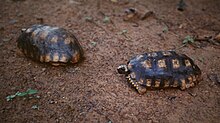Chelonoidis
Appearance
| Chelonoidis | |
|---|---|

| |
| Brazilian giant tortoise | |
| Scientific classification | |
| Kingdom: | |
| Phylum: | |
| Class: | |
| Subclass: | |
| Order: | |
| Suborder: | |
| Superfamily: | |
| Family: | |
| Genus: | Chelonoidis |
Chelonoidis is a genus of turtles in the tortoise family.[1][2] They are found in South America and the Galápagos Islands. They were formerly assigned to Geochelone, but a recent comparative genetic analysis has indicated that they are actually most closely related to African hingeback tortoises.[3] Their ancestors apparently floated across the Atlantic in the Oligocene.[3] This crossing was made possible by their ability to float with their heads up and to survive up to six months without food or water.[3]
The members of this genus on the Galápagos Islands are among the largest extant terrestrial chelonians. Giant members of the genus were also present in mainland South America during the Pleistocene.[4]
Species
- C. carbonaria – red-footed tortoise
- C. chilensis – Chaco tortoise
- C. denticulata – yellow-footed tortoise
- C. nigra species complex
- †C. abingdonii – Pinta Island tortoise (extinct)
- C. becki – Volcán Wolf Galápagos tortoise
- C. chathamensis – San Cristobal Island Galápagos tortoise
- C. darwini – Santiago Island Galápagos tortoise
- C. donfaustoi – Eastern Santa Cruz tortoise[5][6]
- C. duncanensis – Pinzon Island Galápagos tortoise
- C. guentheri – Sierra Negra Galápagos tortoise
- C. hoodensis – Española Island Galápagos tortoise
- C. microphyes – Volcán Darwin Galápagos tortoise
- †C. nigra – Floreana Island Galápagos tortoise (extinct)
- †C. phantastica – Fernandina Island Galápagos tortoise (doubtful existence)[7]
- C. porteri – Santa Cruz Island Galápagos tortoise
- C. vandenburghi – Volcán Alcedo Galápagos tortoise
- C. vicina – Isabela Island Galápagos tortoise
- †C. wallacei – Rábida Island Galápagos tortoise (doubtful existence)[7][8][9]
- †Chelonoidis sp. 1 – Santa Fe Island Galápagos tortoise[9] (doubtful existence)[7]
- †Chelonoidis sp. 2 – El Fatal Island Galápagos tortoise[9] (extinct)
- †Chelonoidis sp. 3 – Cerro Montura Galápagos tortoise[9] (extinct)
References
- ^ a b c Turtle Taxonomy Working Group 2010 (2010-12-14). "Turtles of the World 2010 Update: Annotated Checklist of Taxonomy, Synonymy, Distribution and Conservation Status" (PDF). Archived from the original (pdf) on 2010-12-15. Retrieved 2010-12-15.
{{cite web}}: Unknown parameter|deadurl=ignored (|url-status=suggested) (help)CS1 maint: numeric names: authors list (link) - ^ a b c Turtle Taxonomy Working Group 2011 (2011-12-31). "Turtles of the World 2011 Update: Annotated Checklist of Taxonomy, Synonymy, Distribution and Conservation Status" (PDF). Archived from the original (pdf) on 2012-01-22. Retrieved 2012-07-30.
{{cite web}}: Unknown parameter|deadurl=ignored (|url-status=suggested) (help)CS1 maint: numeric names: authors list (link) - ^ a b c Le, M.; Raxworthy, C. J.; McCord, W. P.; Mertz, L. (2006-05-05). "A molecular phylogeny of tortoises (Testudines: Testudinidae) based on mitochondrial and nuclear genes" (PDF). Molecular Phylogenetics and Evolution. 40 (2): 517–531. doi:10.1016/j.ympev.2006.03.003. PMID 16678445.
- ^ Cione, A. L.; Tonni, E. P.; Soibelzon, L. (2003). "The Broken Zig-Zag: Late Cenozoic large mammal and tortoise extinction in South America" (PDF). Rev. Mus. Argentino Cienc. Nat., n.s. 5 (1): 1–19. ISSN 1514-5158. Retrieved 2011-02-06.
- ^ Poulakakis, Nikos; Edwards, Danielle L.; Chiari, Ylenia; Garrick, Ryan C.; Russello, Michael A.; Benavides, Edgar; Watkins-Colwell, Gregory J.; Glaberman, Scott; Tapia, Washington; Gibbs, James P.; Cayot, Linda J.; Caccone, Adalgisa (2015). "Description of a New Galapagos Giant Tortoise Species (Chelonoidis; Testudines: Testudinidae) from Cerro Fatal on Santa Cruz Island". PLOS ONE. 10 (10): e0138779. doi:10.1371/journal.pone.0138779.
{{cite journal}}: CS1 maint: unflagged free DOI (link) - ^ Marris, Emma (21 October 2015). "Genetics probe identifies new Galapagos tortoise species". Nature News. doi:10.1038/nature.2015.18611.
- ^ a b c Van Denburgh, J. (1914). "The gigantic land tortoises of the Galapagos archipelago". Proceedings of the California Academy of Sciences, Series 4. 2 (1): 203–374. Retrieved 2012-01-11.
- ^ MacFarland; Craig G.; Villa, José; Toro, Basilio (1974). "The Galápagos giant tortoises (Geochelone elephantopus). I. Status of the surviving populations". Biological Conservation. 6 (2): 118–133. doi:10.1016/0006-3207(74)90024-X.
- ^ a b c d "Darwin Foundation". Retrieved 12 June 2015.

